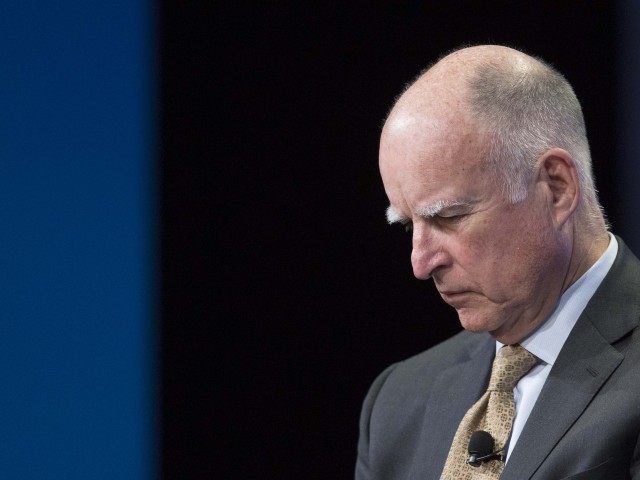Despite California Gov. Jerry Brown’s full-court-press to cast himself as the ultimate climate change warrior, the Porter Ranch gas leak has trashed his relevance to the movement and made the governor an environmental “lame duck.”
Brown has worked tirelessly over the last six years to burnish his environmentalist credentials and make California the international leader in fighting climate change.
As he came into office in 2011, the global battle against climate change was imploding. The Durban, South Africa UN COP17 meeting to craft an international agreement to reduce carbon dioxide emissions had failed to create a “legal instrument” requiring the developed countries to make $100 billion a year in cash transfers to the developing countries to fund the so-called Green Climate Fund to help wean them off fossil fuels.
Environmentalists in 2012 were still claiming that a “peak oil event” had already happened and the world was facing a catastrophic loss of fossil-fuel based electric power availability for heating and cooling.
Brown was trying to portray himself as a moderate by demanding penalties for major polluters, while unshackling industrial development and supporting the oil industry’s push for more drilling to create more jobs.
But then Brown enlisted California’s former hedge fund and coal baron, Tom Steyer, to help pass Proposition 39, which would raise taxes by $1 billion and recycle over half of the cash into subsidies to “create energy efficiency and clean energy jobs.”
After Prop 39 passed by over 60 percent, Steyer announced that he was launching the world’s largest Super PAC, with up to $100 million supporting state and local candidates in the 2014 elections cycle. Gov. With Steyer funding the movement, Brown went all-in to push the radical left’s climate change agenda.
Steyer’s Next Gen Climate Action Committee would spend a total of $66.9 million on Congressional and gubernatorial campaigns in 2014. That was almost three times the $27.7 million spent by the second-biggest individual donor, former New York City Mayor Michael Bloomberg.
Steyer also poured tens of millions of dollars more into social media organizing, influencing legislation that addresses climate change, and running social media ads to attack any global warming deniers. He almost single-handedly funded all of the 90-second ads that built support to shut down approval for the Keystone XL pipeline.
Early in 2015, Brown issued an executive order to reduce greenhouse gas emissions in California 40 percent below 1990 levels by 2030. He said the new regulations were the most ambitious target in North America and consistent with California’s existing commitment to reduce emissions 80 percent under 1990 levels by 2050.
By last summer, the governor had signed 2 memoranda of understanding (MOUs) between California and foreign leaders from Mexico, Israel, Peru, China and Japan. He also helped facilitate an effort for hundreds of world-renowned researchers and scientists to issue a groundbreaking climate change call to action, called the consensus statement.
Brown trotted out progressive-leaning companies – led by Facebook, Apple and Dignity Health – to support a post-petroleum world as envisioned in state Senate Bill 32 and Senate Bill 350 in August. The legislation authorized the California Air Resources Board to boost and implement regulatory enforcement to cut fossil fuel use dramatically.
Having earned a coveted place alongside President Barack Obama as a member of the U.S. delegation to the United Nations Conference of Parties (COP 21) in Paris, Brown told the Silicon Valley Business Journal he would wage a “life-and-death struggle” to “change the very basis of our industrial economy.”
But unknown to the public in the fall, Southern California Gas Company workers discovered a leak in one of the over 110 wells at the Aliso Canyon natural gas storage facility near Southern California’s Porter Ranch on October 23. The leak was estimated at the time to be spewing over 110,000 pounds of methane gas per hour.
Despite weeks of mounting complaints from residents and environmentalists, Gov. Brown failed to use his executive authority to issue a state of emergency that would have relocated residents.
As Breitbart News noted in “Jerry Brown: Another Energy Conflict of Interest,” the governor’s sister, former California State Treasurer Kathleen L. Brown, was receiving $188,380 a year as a board member of Sempra Energy, the parent of Southern California Gas Company. Despite that family conflict, Brown did not recuse himself.
The Los Angeles County and the City and School Boards finally declared their own “state of emergency.” Over 7,000 residents would be relocated, and the leak was eventually sealed in February.
But by then, 107,000 tons of climate-changing methane and ethane had been leaked, and Brown’s reputation in the environmentalist community was shattered. Instead of being dubbed a savior for all his hard work fighting climate change, he now is often portrayed as a villain by many environmentalists.

COMMENTS
Please let us know if you're having issues with commenting.